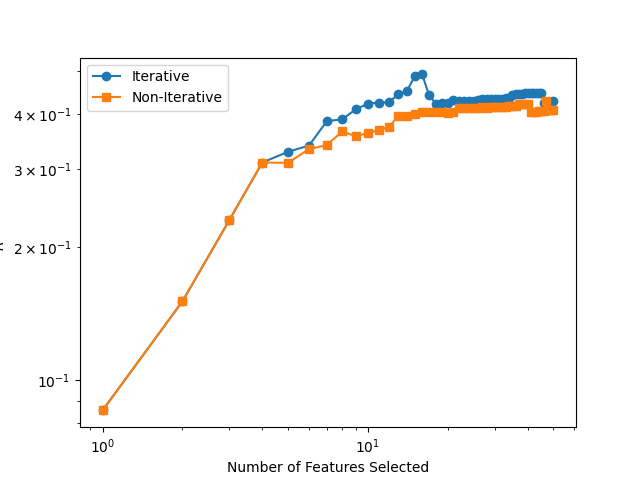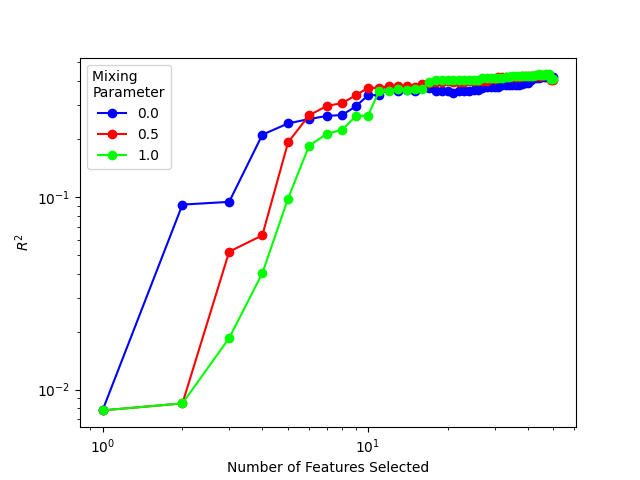Note
Go to the end to download the full example code.
PCovR-Inspired Feature Selection#
import numpy as np
from matplotlib import cm
from matplotlib import pyplot as plt
from sklearn.linear_model import RidgeCV
from sklearn.preprocessing import StandardScaler
from skmatter.datasets import load_csd_1000r
from skmatter.feature_selection import CUR, FPS, PCovCUR, PCovFPS
from skmatter.preprocessing import StandardFlexibleScaler
cmap = cm.brg
For this, we will use the provided CSD dataset, which has 100 features to select from.
X, y = load_csd_1000r(return_X_y=True)
X = StandardFlexibleScaler(column_wise=False).fit_transform(X)
y = StandardScaler().fit_transform(y.reshape(X.shape[0], -1))
n = X.shape[-1] // 2
lr = RidgeCV(cv=2, alphas=np.logspace(-10, 1), fit_intercept=False)
Feature Selection with CUR + PCovR#
First, let’s demonstrate CUR feature selection, and show the ten features chosen with a mixing parameter of 0.0, 0.5, and 1.0 perform.
for m in np.arange(0, 1.01, 0.5, dtype=np.float32):
if m < 1.0:
idx = PCovCUR(mixing=m, n_to_select=n).fit(X, y).selected_idx_
else:
idx = CUR(n_to_select=n).fit(X, y).selected_idx_
plt.loglog(
range(1, n + 1),
np.array(
[
lr.fit(X[:, idx[: ni + 1]], y).score(X[:, idx[: ni + 1]], y)
for ni in range(n)
]
),
label=m,
c=cmap(m),
marker="o",
)
plt.xlabel("Number of Features Selected")
plt.ylabel(r"$R^2$")
plt.legend(title="Mixing \nParameter")
plt.show()

Non-iterative feature selection with CUR + PCovR#
Computing a non-iterative CUR is more efficient, although can result in poorer
performance for larger datasets. you can also use a greater number of
eigenvectors to compute the feature importance by varying k, but k should
not exceed the number of targets, for optimal results.
m = 0.0
idx = PCovCUR(mixing=m, n_to_select=n).fit(X, y).selected_idx_
idx_non_it = PCovCUR(mixing=m, recompute_every=0, n_to_select=n).fit(X, y).selected_idx_
plt.loglog(
range(1, n + 1),
np.array(
[
lr.fit(X[:, idx[: ni + 1]], y).score(X[:, idx[: ni + 1]], y)
for ni in range(n)
]
),
label="Iterative",
marker="o",
)
plt.loglog(
range(1, n + 1),
np.array(
[
lr.fit(X[:, idx_non_it[: ni + 1]], y).score(X[:, idx_non_it[: ni + 1]], y)
for ni in range(n)
]
),
label="Non-Iterative",
marker="s",
)
plt.xlabel("Number of Features Selected")
plt.ylabel(r"$R^2$")
plt.legend()
plt.show()

Feature Selection with FPS + PCovR#
Next, let’s look at FPS. We’ll choose the first index from CUR at m = 0, which is 46.
for m in np.arange(0, 1.01, 0.5, dtype=np.float32):
if m < 1.0:
idx = PCovFPS(mixing=m, n_to_select=n, initialize=46).fit(X, y).selected_idx_
else:
idx = FPS(n_to_select=n, initialize=46).fit(X, y).selected_idx_
plt.loglog(
range(1, n + 1),
np.array(
[
lr.fit(X[:, idx[: ni + 1]], y).score(X[:, idx[: ni + 1]], y)
for ni in range(n)
]
),
label=m,
c=cmap(m),
marker="o",
)
plt.xlabel("Number of Features Selected")
plt.ylabel(r"$R^2$")
plt.legend(title="Mixing \nParameter")
plt.show()
